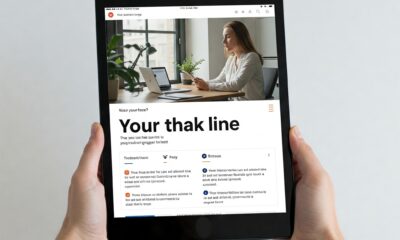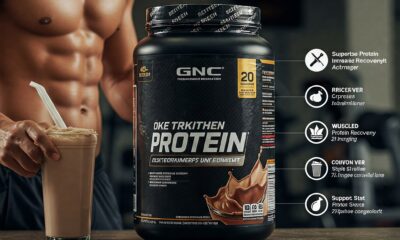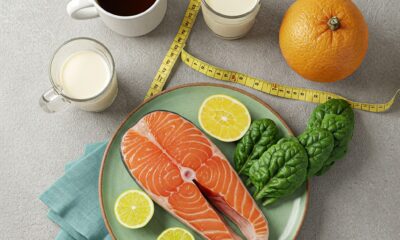Nutrition
19 30-Minute High-Protein Lunches for Heart Health
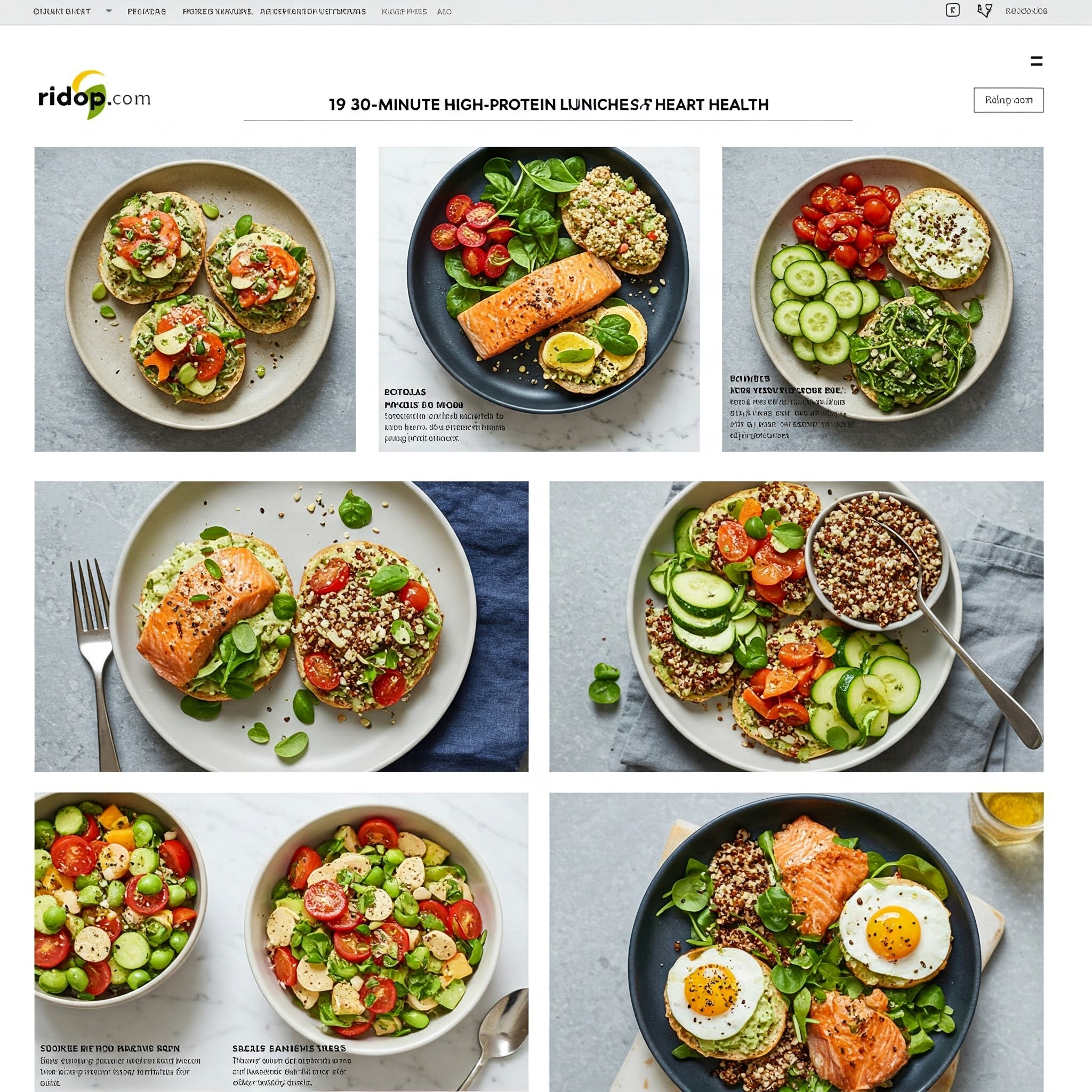
Thirty minutes is all you’ll need for this delicious lunch! They’re all high in protein, with at least 15 grams each. Packed with nutritious ingredients like legumes, vegetables and whole grains, they’re a healthy choice. except for those who want to support their heart health while watching their sodium and saturated fat intake. With options like Sweet Potatoes Stuffed with Sweet Dressing and Green Goddess Salad with Chickpeas, there’s no shortage of lunch inspiration to help you reach your health goals.
Hummus Dressed Sweet Potatoes
Ali Redmond
Delicious yet easy to prepare, these mashed potatoes with black beans, kale and hummus are a delicious 5-for-1 meal!
Green goddess salad with chickpeas
In this cucumber, tomato, Swiss cheese, and chickpea salad recipe, a healthy green goddess dressing is made with avocado, buttermilk, and herbs. The extra dressing is great to use with roasted vegetables.
Lemon Shrimp and Orzo Salad
Consider making two batches of this easy pasta salad—it’s delicious the next day. The orzo will absorb the dressing as it sits, so add a little olive oil and lemon juice if you like.
Beef & Bean Sloppy Joes
This healthy copycat recipe swaps out the beans for some meat, minus 7 grams of fiber. We also cut back on the sugar and ketchup in this Sloppy Joe recipe to save you 12 grams. of added sugar.
Southwest Black-Bean Pasta Salad Bowls
In this Southwestern pasta salad, we use black bean pasta to bump up the fiber to an impressive 14 grams per serving, paired with seasoned chicken and sweet corn salad.
Superfood Chopped Salad with Salmon & Creamy Garlic Dressing
This healthy copycat recipe swaps out the beans for some meat, minus 7 grams of fiber. We also cut back on the sugar and ketchup in this Sloppy Joe makeover to save you 12 grams. of added sugar.
Spicy Slaw Bowls with Shrimp & Edamame
A quick 10-minute Spicy Cabbage Slaw serves as the low-carb base for this veggie-packed lunch. Topped with protein-rich edamame and shrimp, this satisfying lunch will get you through the afternoon.
Kale & Chickpea Cereal Bowls
This veggie-heavy bowl is bursting with color and texture, thanks to crispy carrots and chickpeas, fresh kale and a delicious avocado dressing. It also provides more than 50% of your daily dose of fiber, the key to weight loss, energy and healthy digestion.
Chopped Salad with Sriracha Tofu and Peanut Dressing
Prepare a protein-rich lunch using just four ingredients from your grocery store, including a veggie-heavy salad dressing as a base. Because this salad dressing is delicious, you can dress these bowls up to 24 hours before serving to allow the flavors of this healthy salad to marry.
Vegan Superfood Cereal Bowls
Photographer: Fred Hardy, Food Styling: Margaret Monroe Dickey
This nutrient-dense whole grain recipe comes together in 15 minutes with the help of a few simple food shortcuts like baby kale, microwavable quinoa and pre-cooked beets. Make these ahead of time to keep on hand for an easy lunch or dinner on a busy night.
Strawberry-Balsamic Arugula Salad
This fruity green salad with chicken offers an explosion of flavors in each bite. The flavors of sweet strawberries, peppery arugula and tangy feta cheese are enhanced by a strong balsamic vinaigrette dressing.
Chimichurri Noodle Bowls
We combine whole-grain spaghetti with zucchini noodles to add volume and save calories in these easy, flavor-packed bowls that are prepared with a light sauce and herby chimichurri. Leftover chicken, tofu or canned beans can be substituted for the shrimp.
Chopped Cobb Salad with Chicken
This healthy cooked salad is a great way to use up leftover cooked meat. You can save half a hard-boiled egg for a snack.
Tofu & Snow Pea Cost-Fry with Peanut Sauce
A quick dinner recipe perfect for busy weeknights, this easy recipe will become a favorite in no time. To save time, use pre-cooked rice or cook the rice the next day.
Chickpeas and Crispy Roasted Pepper Lettuce with Tahini Dressing
A delicious tahini dressing combines no-cook ingredients like canned peas and roasted red peppers for these easy lettuce wraps. Make these wraps ahead of time for lunch or dinner. A few warm pita wedges complete the meal perfectly.
Spinach and Egg Scramble with Raspberries
Cover Veggies with Cilantro Hummus
These healthy multi-grain wraps are filled with mixed greens, diced cucumbers, tomatoes and red onion, along with feta cheese and homemade cilantro hummus. As a time saver, hummus can be prepared up to 3 days ahead, and refrigerated until you’re ready to make the wraps.
Red Beans and Rice with Chicken
High-fiber red beans, whole-grain brown rice, and skillet-cooked chicken breast are ready in just 20 minutes.
Food-Prep Curried Chicken Bowls
Curry doesn’t have to take hours to prepare. With the help of our paper-pan chicken (see related recipe) and cooked grains, you can make these meal prep bowls in minutes! Keep them in the fridge for an easy dinner on a busy weeknight or for healthy lunches throughout the week.
#30Minute #HighProtein #Lunches #Heart #Health
Nutrition
Aren’t You Sleeping? New Research suggests that Creatine can instantly boost your brain

You probably don’t need an education to tell you that lack of sleep can seriously affect your mental performance. But if you’re still on the fence, there is a lot of research to support the fact that getting less than seven to eight hours a night can wreak havoc on your ability to perform even basic daily tasks.
While our number one tip will always be ‘get enough sleep’, new research offers a possible boost for those days when a full night’s rest just wasn’t possible and your morning coffee not reduced: creatine.
In a new study published in Scientific Reports, researchers found that a single high dose of creatine can significantly prevent cognitive decline caused by sleep deprivation. Known for its muscle strengthening benefits, creatine has also been researched for its role in brain strengthening, but these studies often focus on the long-term effects of small doses. This new study shows that high doses can have immediate benefits for your mental performance, especially when you are inactive.
After a sleepless night, your brain feels foggy and your reaction time slows to a crawl. This cognitive decline may be caused by a depletion of high-energy molecules in the brain. Scientists, already aware of the long-term benefits of creatine supplementation in these molecules, conducted experiments to see if a larger dose of creatine could damage the sleep-deprived brain more quickly.
The study
Participants in the study were given a large amount of creatine monohydrate – 0.35 grams per kilogram of body weight, around 20-30g – while they were awake for 21 hours straight. Their cognitive performance and brain chemistry were monitored at different times after taking the supplement. This involved doing a number of battery selection tests, memory tasks and various math and language tests.
Results
The findings paint a convincing picture and are good news for those of us who often find ourselves in the wrong position of a long night. Using high doses of creatine, researchers found:
- It improved the balance of important energy molecules in the brain.
- Prevents a drop in pH levels in the brain – essential for proper brain function.
- Improved mental performance and processing speed, helping participants to think clearly and act quickly.
What This Means for Us
This study suggests that a single high dose of creatine can provide rapid brain power during sleep deprivation, which can be a game changer for late night work sessions or early morning meetings. after a restless night.
The Bottom Line
Forget the old opinion that creatine only works for increasing or strengthening the bench press. This versatile and cost-effective supplement may be your new secret weapon for staying sharp and on top of your mental game, even when you’re short on sleep. short.

With nearly 18 years in the health and fitness space as a personal trainer, nutritionist, breathing coach and author, Andrew has spent nearly half of his life exploring how helping people improve their bodies and minds.
As our fitness editor, he prides himself on keeping Men’s Health at the forefront of reliable, trustworthy and reliable fitness information, whether it’s by writing and testing thousands of fitness tests each year. instead, delve deeper into the science of muscle building and fat loss or explore the psychology of performance and recovery.
While developing his knowledge base through workshops and courses, Andrew loves practical learning as much as theory, and constantly puts his training to the test in everything from competitions from Crossfit and strongman, to multiple marathons, to hours of 24-hour training and (very unofficial) world record attempts.
You can find Andrew on Instagram at @theandrew.tracey, or just hold up the ‘free pizza’ sign and wait for him to appear.
#Arent #Sleeping #Research #suggests #Creatine #instantly #boost #brain
Nutrition
Everything that happens to your body when you stop eating sugar
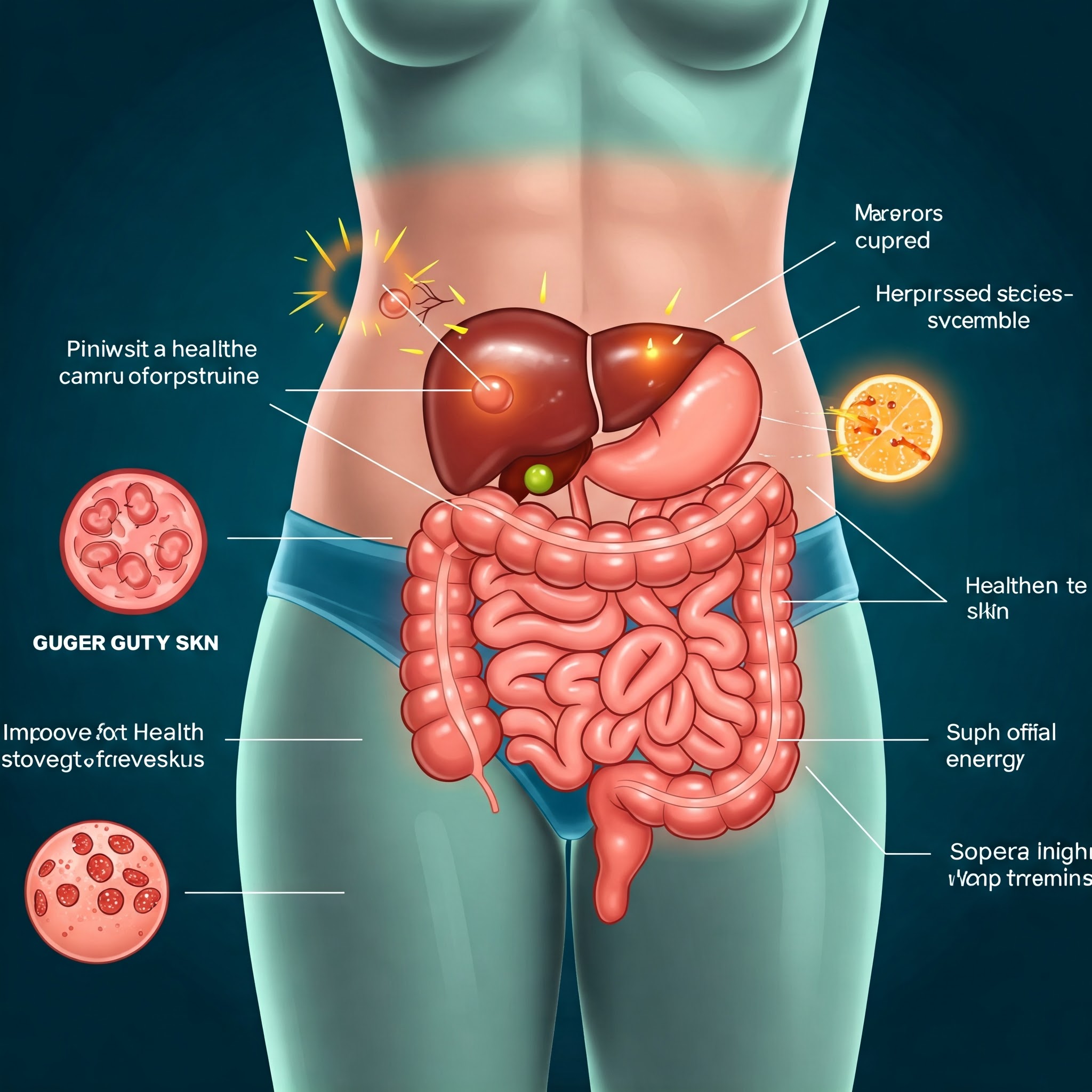
Aquí hay un artículo sobre los efectos de dejar de consumir azúcar, basado en la información que encontré, traducido al inglés:
Everything That Happens to Your Body When You Stop Eating Sugar
Quitting sugar can have surprising effects on your body, both in the short and long term. Although it can be difficult at first, the benefits for your health are worth the effort.
Sugar Withdrawal Symptoms
When you stop eating sugar, your body may experience withdrawal symptoms similar to those of other addictions. These symptoms can last from a few days to several weeks, and their intensity varies from person to person. Some of the most common symptoms include:
- Intense sugar cravings: This is perhaps the most common and difficult symptom to control.
- Headaches: Changes in blood sugar levels can cause headaches.
- Fatigue: Lack of sugar can make you feel tired and without energy.
- Nausea: Some people experience nausea when they stop eating sugar.
- Irritability: Mood swings are common during sugar withdrawal.
- Anxiety: Lack of sugar can increase feelings of anxiety.
- Concentration problems: It can be difficult to concentrate when the body is adjusting to the lack of sugar.
- Changes in sleep: Some people may have trouble sleeping at first.
Long-Term Benefits of Quitting Sugar
Once you overcome the withdrawal symptoms, you will begin to experience the numerous health benefits of quitting sugar. Some of these benefits include:
- Weight loss: Reducing sugar consumption can help with weight loss and maintaining a healthy weight.
- Improved heart health: Lowering sugar intake reduces the risk of heart disease, lowering blood pressure and improving cholesterol levels.
- Reduced risk of type 2 diabetes: Controlling sugar consumption improves insulin sensitivity and reduces the risk of developing type 2 diabetes.
- Improved dental health: Sugar feeds the bacteria in the mouth that cause cavities and gum disease. Reducing sugar consumption improves dental health.
- Clearer and younger skin: Sugar can damage collagen and elastin, leading to wrinkles and acne. Quitting sugar improves the appearance of the skin.
- Better mood: Sugar can cause mood swings and depression. Reducing its consumption can improve mood and reduce symptoms of depression.
- Increased energy: Although it can cause fatigue at first, in the long run, reducing sugar consumption provides more stable energy levels throughout the day.
- Improved brain function: Sugar can negatively affect cognitive function. Reducing its consumption improves mental clarity and concentration.
- Reduced risk of non-alcoholic fatty liver disease (NAFLD): Excess sugar, especially fructose, can lead to the accumulation of fat in the liver. Reducing sugar consumption decreases the risk of NAFLD.
Tips for Reducing Sugar Consumption
- Read food labels: Many processed foods contain added sugars.
- Cook at home more often: This allows you to control the amount of sugar you consume.
- Gradually reduce sugar consumption: This can help minimize withdrawal symptoms.
- Choose healthy alternatives: Opt for fruits, vegetables, and whole grains instead of processed and sugary foods.
- Stay hydrated: Drinking enough water can help control sugar cravings.
Quitting sugar can be a challenge, but the benefits for your health are numerous. With patience and determination, you can achieve it and enjoy a healthier and happier life.
Nutrition
The Ultimate 7-Day Diet Plan to Lower Triglycerides, Designed by a Nutritionist.
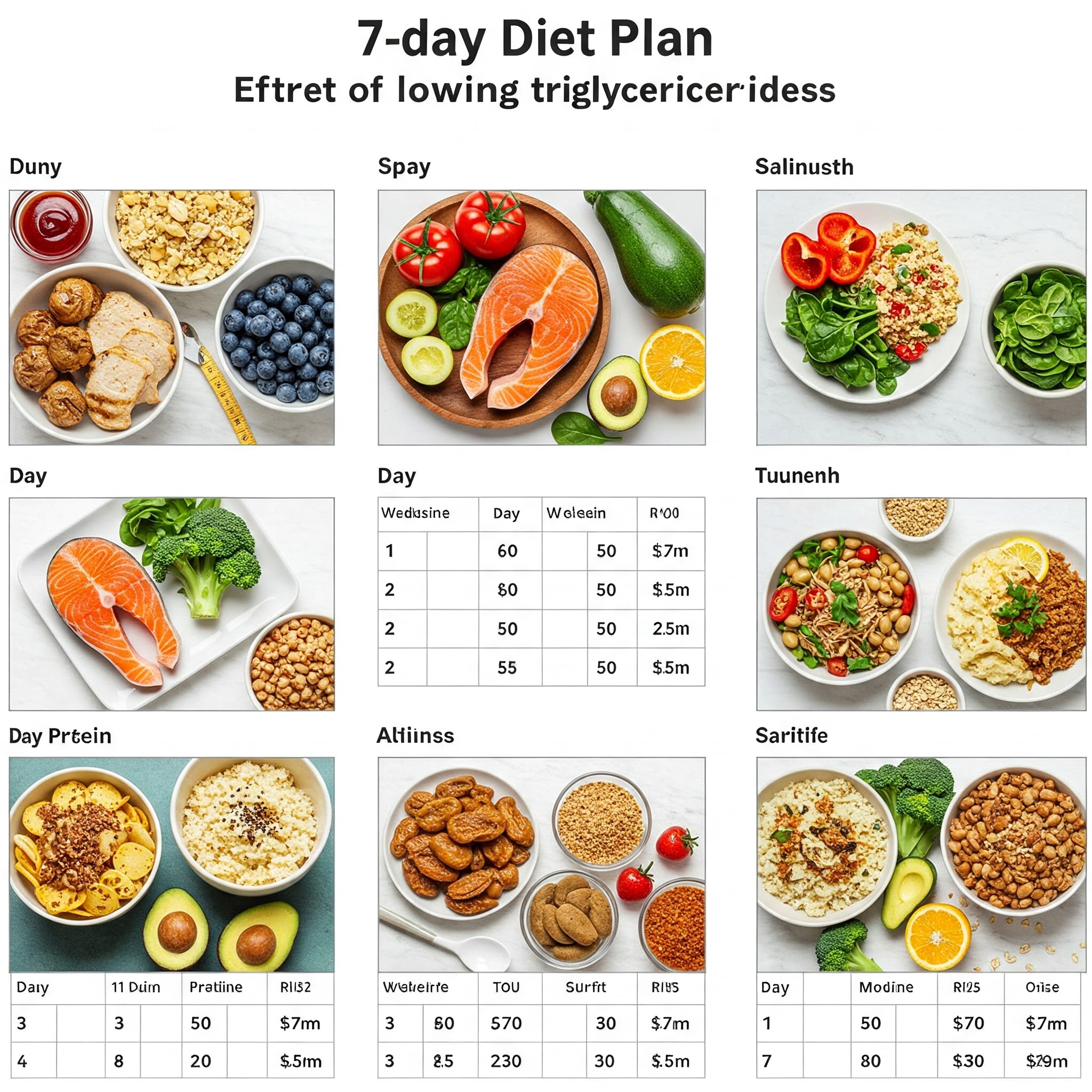
Triglycerides, sometimes called lipids, are the most common type of fat in the body. They often contain cholesterol because high cholesterol and high triglycerides can increase the risk of heart disease, and both of these conditions can be positively affected by changes in heart health. In this seven-day diet plan, we focus on fiber to help lower triglyceride levels. Fiber is an important nutrient that has many health benefits, including reducing the risk of heart disease. If you currently have high triglycerides, have been told you are at risk or simply want to increase your fiber intake, this meal plan may work for you.
How We Make Meal Plans
Registered dietitians act thoughtfully EatingWell’s Meal plans are easy to follow and fun. Each meal plan meets specific criteria based on the health conditions and / or lifestyle goals you are aiming for and is analyzed for accuracy using the nutritional database, ESHA Food Processor. Since nutritional needs vary from person to person, we encourage you to use these plans as inspiration and modify as you see fit.
Why This Meal Plan Is Good For You
Each day provides at least 31 grams of fiber. Fiber is associated with many health benefits, yet many of us do not meet our daily goals. The average American consumes 14 grams of fiber per day, less than the recommended Daily Value of 28 grams per day. While we’re focusing on fiber here, we didn’t skip another important nutrient: protein. Each day provides at least 84 grams. In addition to fiber and protein, we include many heart-healthy foods, such as fruits, vegetables, beans, nuts, seeds, whole grains and a fish.
This 1,800-calorie meal plan has variations for 1,500 and 2,000 calories to support those with different calorie needs. While we used to include meal plans and 1,200 calorie conversions, we no longer do. The 2020-2025 Dietary Guidelines for Americans suggest that cutting your calories to 1,200 per day is too low for most people to meet their nutritional needs, and is not feasible for long-term health and wellness. As with all meal plans, this is intended to serve as a blueprint for a healthy, high-fiber diet. Make adjustments as needed based on your taste preferences, habit, pantry stock and family size.
Frequently Asked Questions
-
Is it okay to combine foods if there are some I don’t like?
Indeed! Feel free to mix and match meals, repeat a meal or two or swap out a different high-fiber recipe. We aimed to get at least 31 grams of fiber per day. If you’re watching fiber or other nutrients carefully, you may want to choose something else with the same nutritional value or make changes in other areas to meet your goals.
-
Can I eat the same breakfast or lunch every day?
Yes, we offer several different options for breakfast and lunch but you can choose to eat breakfast and lunch every day if it is convenient for your schedule. you. Each breakfast ranges from 409 to 469 calories while lunch ranges from 486 to 514. These ranges are exactly the same, so choosing one of these options you can eat them every day should keep the total daily nutrition close.
-
What causes high triglycerides?
High triglycerides can be caused by many factors, such as excess calories stored as triglycerides in the blood, lack of exercise, eating too many foods high in fat and added sugar as well as drinking alcohol. Fortunately, lifestyle changes such as increasing exercise, increasing fiber, reducing alcohol and losing weight can help improve triglyceride levels.
-
Why is there no change for 1,200 calories?
We no longer offer adjustments for 1,200-calorie days in our meal plans. The 2020-2025 Dietary Guidelines for Americans suggest that cutting calories to 1,200 per day is too low for most people to meet their nutritional needs, and is not feasible for health and long-term health.
How Fiber Helps Lower Triglycerides
Fiber is a type of unsaturated carbohydrate that helps improve blood sugar levels, aid in weight loss, regulate digestion and improve heart health. Increased fiber intake is often recommended as a strategy to reduce high cholesterol, but does eating more fiber have a positive effect on triglycerides? Research shows that eating more fiber is associated with lower triglyceride levels in adults who are overweight or obese. With a wide range of positive health effects, aiming to eat more fiber is a strategy that many people can benefit from.
High-Fiber Foods to Focus on:
- Fruits
- Vegetables
- Whole grains
- Nuts
- Seeds
- Avocado
- Beans
- Lens
- Peas
How to Prepare Your Meals for the Week:
- Make High Protein Strawberries and Peanut Butter Overnight Oats for breakfast on Days 2 to 4.
- Prepare Chicken and Cabbage Soup with Pesto for lunch in Days 2 to 5.
Day 1
Breakfast (409 calories)
AM Snack (217 calories)
Lunch (486 calories)
PM Snack (234 calories)
- ¼ cup of toasted undried almonds
- ⅓ cup blueberries
Dinner (464 calories)
Statistics of the Day: 1,811 calories, 80g fat, 115g protein, 166g carbohydrates, 36g fiber, 1,794mg sodium
Make it 1,500 calories: Cut back to 1 serving of roasted Buffalo Chickpeas during the AM snack and omit the almonds during the PM snack.
Make it 2,000 calories: Add 1 medium banana and 1 Tbsp. almond butter as a snack.
Day 2
Ali Redmond
Breakfast (443 calories)
AM Snack (217 calories)
Lunch (514 calories)
PM Snack (131 calories)
Dinner (470 calories)
Statistics of the Day: 1,775 calories, 53g fat, 119g protein, 205g carbohydrate, 32g fiber, 1,901mg sodium
Make it 1,500 calories: Skip the kefir at breakfast, reduce to 1 serving of roasted Buffalo Chickpeas in the AM snack and change the PM snack to 1 medium apple.
Make it 2,000 calories: Add 1 medium banana and 1 Tbsp. almond butter as a snack.
Day 3
Breakfast (443 calories)
AM Snack (131 calories)
Lunch (514 calories)
PM Snack (234 calories)
- ¼ cup of toasted undried almonds
- ⅓ cup blueberries
Dinner (482 calories)
Statistics of the Day: 1,804 calories, 82g fat, 105g protein, 170g carbohydrate, 31g fiber, 1,900mg sodium
Make it 1,500 calories: Skip kefir at breakfast and almonds at PM snack.
Make it 2,000 calories: Add 1 medium banana and 1 Tbsp. almond butter as a snack.
Day 4
Actor: Stacy k. Allen, Props: Christina Brockman, Food Styling: Jennifer Wendorf
Breakfast (443 calories)
AM Snack (176 calories)
Lunch (514 calories)
PM Snack (172 calories)
- 1 cup blackberries
- 1 (5.3-oz.) container low-fat plain yogurt
Dinner (502 calories)
Statistics of the Day: 1,806 calories, 58g fat, 121g protein, 203g carbohydrate, 31g fiber, 1,965mg sodium
Make it 1,500 calories: Skip the kefir at breakfast, change the AM snack to 1 medium apple and skip the yogurt at the PM snack.
Make it 2,000 calories: Add to 4 servings of Pecan Pie Energy Balls in the AM snack and add 3 Tbsp. selected walnuts in PM.
Day 5
A picture of respect
Breakfast (469 calories)
AM Snack (176 calories)
Lunch (514 calories)
PM Snack (152 calories)
- 1 medium apple
- 1 (0.5-oz.) slice of Cheddar cheese
Dinner (489 calories)
Statistics of the Day: 1,800 calories, 80g fat, 84g protein, 203g carbohydrate, 40g fiber, 1,987mg sodium
Make it 1,500 calories: Skip the horse at breakfast, change the AM snack to 1 medium peach and skip the Cheddar cheese at the PM snack.
Make it 2,000 calories: Add 1 medium banana and 1 Tbsp. almond butter as a snack.
Day 6
Breakfast (409 calories)
AM Snack (176 calories)
Lunch (486 calories)
PM Snack (105 calories)
Dinner (609 calories)
Statistics of the Day: 1,785 calories, 69g fat, 111g protein, 191g carbohydrates, 34g fiber, 2,110mg sodium
Make it 1,500 calories: Change the AM snack to 1 medium peach, skip the yogurt at lunch and change the PM snack to 1 medium orange.
Make it 2,000 calories: Add 2 Tbsp. almond butter in PM snack.
Day 7
Photographer Victor Protasio, Food Stylist Julian Hensarling, Prop Stylist Tucker Vines
Breakfast (469 calories)
AM Snack (176 calories)
Lunch (486 calories)
PM Snack (136 calories)
- 1 medium peach
- 1 large hard-boiled egg
Dinner (523 calories)
Statistics of the Day: 1,790 calories, 82g fat, 92g protein, 185g carbohydrate, 33g fiber, 2,227mg sodium
Make it 1,500 calories: Skip the horse at breakfast, the yogurt at lunch and the peach at the PM snack.
Make it 2,000 calories: Add ¼ cup of toasted unsalted almonds as a snack.
#Ultimate #7Day #Diet #Plan #Triglycerides #Designed #Nutritionist
-

 Mental health10 meses ago
Mental health10 meses ago7 Magical Rituals That Convince Even the Most Nervous People
-

 Mental health10 meses ago
Mental health10 meses agoThe Playbook Seeking to Transform Cognitive Processing Technology
-
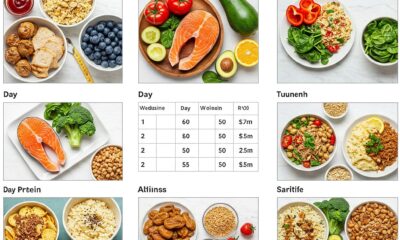
 Nutrition10 meses ago
Nutrition10 meses agoThe Ultimate 7-Day Diet Plan to Lower Triglycerides, Designed by a Nutritionist.
-

 Medication10 meses ago
Medication10 meses agoAngry patients are pushing for new government advocates to lower drug prices
-

 Mental health10 meses ago
Mental health10 meses agoAsking Eric: A chronic cough causes social anxiety
-

 Business1 día ago
Business1 día agoSave Money in the USA: Shield Your Finances from Economic Shifts!
-

 Medication10 meses ago
Medication10 meses agoUdupi: Krishnaveni Ashrayadhamaa, Ayurveda Treatment and Wellness Center established
-

 Mental health10 meses ago
Mental health10 meses agoBetterHelp 101: Understanding Online Therapy and How to Find Support (Sponsored)



